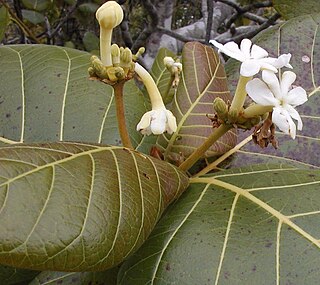
Ancistrocladus is a genus of woody lianas in the monotypic family Ancistrocladaceae. The branches climb by twining other stems or by scrambling with hooked tips. They are found in the tropics of the Old World.
Aneilema silvaticum is a species of plant in the family Commelinaceae. It is found in Cameroon, the Democratic Republic of the Congo, and Nigeria. Its natural habitat is subtropical or tropical moist lowland forests. It is threatened by habitat loss.
Anthocleista scandens is a species of plant in the family Gentianaceae. It is found in Cameroon, Equatorial Guinea, Nigeria, and São Tomé and Príncipe. Its natural habitats are subtropical or tropical moist lowland forests and subtropical or tropical moist montane forests. It is threatened by habitat loss.
Belonophora ongensis is a species of flowering plant in the family Rubiaceae. It is native to Gabon and Cameroon. Its natural habitat is subtropical or tropical moist lowland forests. It is threatened by habitat loss.
Belonophora is a genus of flowering plants in the family Rubiaceae. It is found in Tropical Africa from Senegal east to Sudan and south to Angola. It was described by Joseph Dalton Hooker in 1873.
Belonophora talbotii is a species of flowering plant in the family Rubiaceae. It is found in Nigeria, Cameroon and Gabon. It is threatened by habitat loss.

Canthium is a genus of flowering plants in the family Rubiaceae. They are shrubs and small trees. The leaves are deciduous and the stems are usually thorny.
Afrocanthium keniense is a species of flowering plant in the family Rubiaceae. It is endemic to Kenya. It is threatened by habitat loss.

Guettarda is a plant genus in the family Rubiaceae. Most of these plants are known by the common name velvetseed.

Pentas lanceolata, commonly known as Egyptian starcluster, is a species of flowering plant in the madder family, Rubiaceae that is native to tropical Africa from Sudan to Democratic Republic of the Congo and Mozambique, as well as Saudi Arabia and Yemen on the Arabian Peninsula. It is known for its wide use as a garden plant where it often accompanies butterfly gardens.
Cuviera is a genus of flowering plants in the family Rubiaceae native to tropical Africa. It was originally described by Augustin Pyramus de Candolle in 1807 and is named after the French naturalist Georges Cuvier.
Aulacocalyx is a genus of flowering plants in the family Rubiaceae. It is found in tropical Africa.
Globulostylis is a genus of flowering plants in the family Rubiaceae. It comprises 8 species growing in Central Africa.
Belonophora coriacea is a species of flowering plant in the family Rubiaceae. It is found in Nigeria, Central African Republic, Cameroon, Equatorial Guinea, Congo-Brazzaville, and Congo-Kinshasa.

Coptosperma is a genus of flowering plants in the family Rubiaceae. It contains 19 species native to Africa, the Arabian Peninsula, and various islands of the Indian Ocean.

Craterispermum is a genus of flowering plants in the family Rubiaceae. It contains 16 species that occur in tropical Africa and Seychelles. It is the only genus in the tribe Craterispermeae, of which the divergence time is estimated at 34.8 million years ago.

Urobotrya is a genus of plants in the family Opiliaceae described as a genus in 1905.
Herbert Fuller Wernham was a British botanist, who from 1909 to 1929 worked at the British Museum, as an assistant in the botany department. From 1911 to 1921 he published extensively on tropical plants and many genera, retiring in 1921 due to ill health (alcoholism).

Protea madiensis, commonly known as the tall woodland sugarbush, is a flowering shrub which belongs to the genus Protea. It is native to the montane grasslands of Sub-Saharan Africa.
Diane Mary Bridson is a British botanist.








